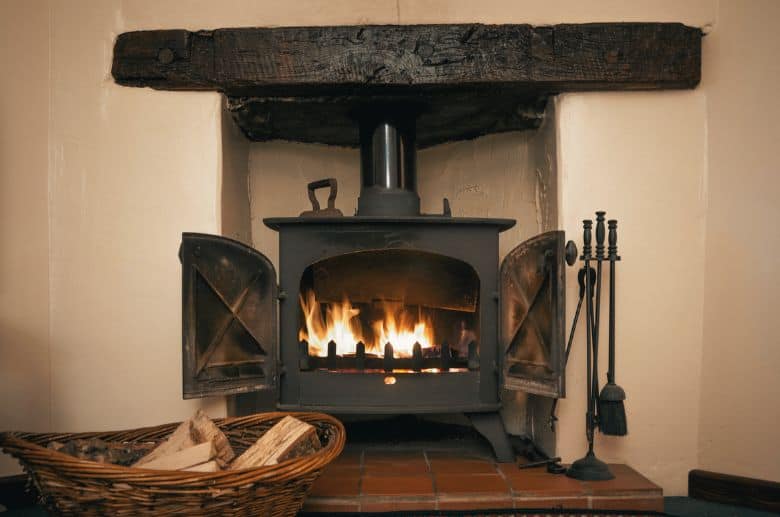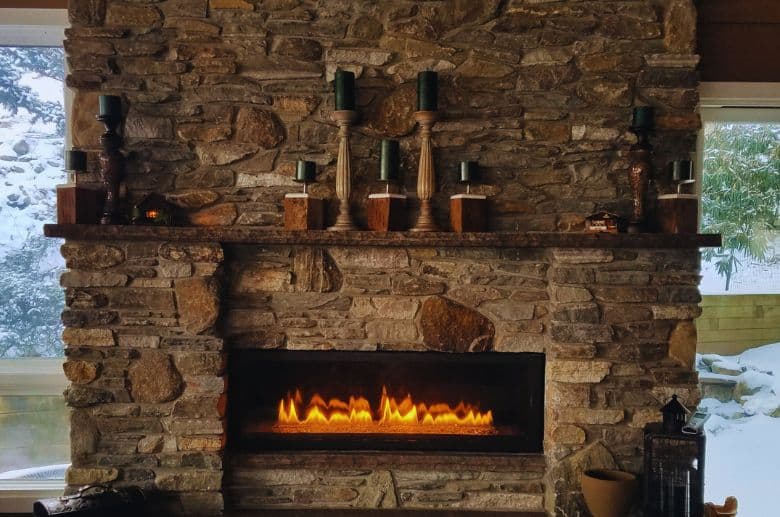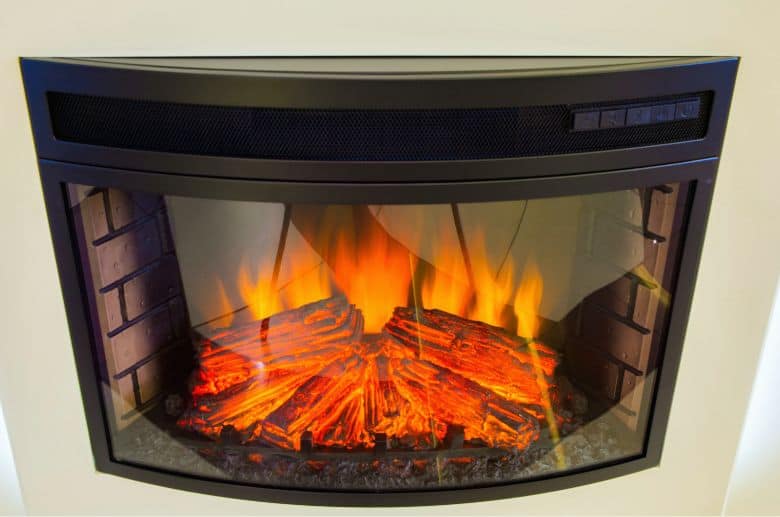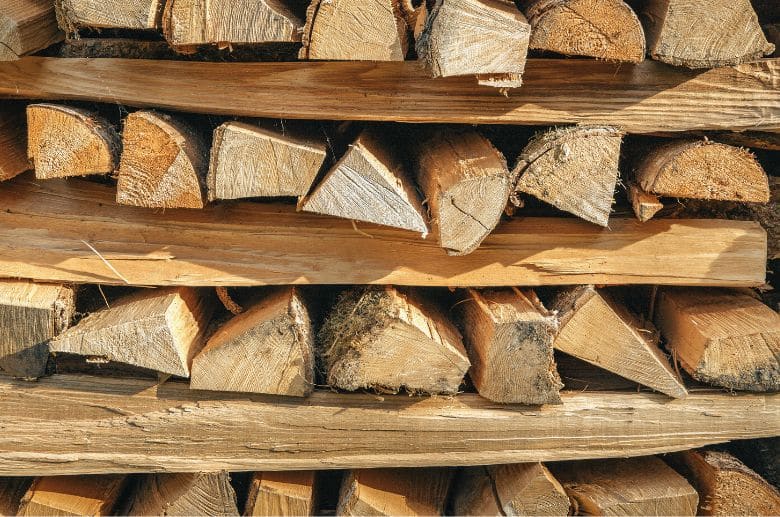The heat produced by a fireplace varies drastically based on factors such as the type of fireplace, fuel type, fireplace size, etc. That is why fireplace temperatures range from 500 °F to 1,000 °F or more.
To know how hot does a fireplace get, it is important to know about all these factors.
Let’s dig deeper into the topic and see how all these factors impact the heat output of a fireplace and how it affects the overall cost of running a fireplace.
How Much Heat Comes Out of a Fireplace?
A fireplace can produce anywhere from a few thousand BTUs to 80,000 BTUs. The amount of heat coming out of any fireplace depends upon various factors, including:
- Fireplace type
- Fireplace size
- Fuel used for combustion
- Fireplace Insulation
Some fireplaces don’t produce a lot of heat; instead, they’re mainly used for decoration. Others produce enough heat to warm up an entire house. For example, gas fireplaces produce more heat than electric fireplaces, which are usually used for decoration.
Ranges of Heat for a Typical Fireplace
Since different fireplace types produce different amounts of heat, it’s better to discuss them individually to answer the question better. Below is a detailed analysis of the heat produced by different types of fireplaces:
How Hot Does a Wood-Burning Fireplace Get?

A wood-burning fireplace can reach temperatures of 1000 and 2000 degrees Fahrenheit. However, the heat output of a wood-burning fireplace mainly depends upon the type of wood used and the amount of wood burnt.
Typically, a well-seasoned cord of hardwood contains about 20 million BTUs of heat energy. When the wood burns, the energy stored inside is released as heat.
The heat output of a wood-burning fireplace can start from a few thousand BTUs. A normal wood-burning fireplace can produce around 20,000 BTUs, while a high-output fireplace can even go upwards of 70,000 BTUs.
How Hot Does a Fireplace Surround Get?
How hot the surround of a wood-burning fireplace gets depends upon the fireplace clearances and the type of material used. A metal surround will get much hotter than a fireplace surround made from stone. But it’s best to stay away from the fireplace surround because it can be too hot to touch, especially for children and pets.
How Hot Does a Wood Stove Get?

A wood stove typically has a temperature range of 375 °F to 800 °F. At temperatures greater than that, the steel parts start to glow red. If the stove is set to run at such high temperatures for a long time, some parts of the stove might start to wrap, or the welds might distort.
How Hot Does a Gas Fireplace Get?

The heat output of a gas fireplace is usually between 10,000 BTUs to 60,000 BTUs. However, the amount of heat a gas fireplace produces depends upon its size, model, and efficiency.
Smaller gas fireplace units typically produce 20,000 BTUs. Medium-sized units can reach up to 30,000 BTUs, while larger units can go upwards of 50,000 BTUs.
How Hot Does a Gas Fireplace Surround Get?
The surrounding glass door of a gas fireplace can reach a temperature of 480°F. It’s best to stay away from the glass and prevent your children and pets from playing anywhere near it.
How Hot Do Electric Fireplaces Get?

Electric fireplaces can usually produce 4,000-9,000 BTUs of heat. A smaller unit can produce around 4,500 BTUs, while an infrared fireplace can produce around 5,500 BTUs. Some electric fireplace units can even produce 8,500+ BTUs.
Can a Fireplace Heat a Whole House?
Fireplaces aren’t usually designed to heat the whole house. But with the correct heat output capacity and placement of the fireplace, a significant amount of warmth can be transferred throughout the house.
But to expect the same level of heating as a central heating unit would be wrong. That’s because the central air system transfers heat into each room through pipes. On the other hand, a fireplace works on the principle of zone heating. Meaning it provides warmth to one zone (or room.)
Since a fireplace sits in one location, the heat has to travel considerable distances to warm the whole house. That is why you feel warmth closer to the fireplace, while the warmth reduces gradually as you get farther away.
——
Do You Need to Hire Chimney & Fireplace Expert?
Get free quotes from qualified experts near you. No commitment required!
——
Fireplace Heat Transfer Methods
In any fireplace, fuel combustion produces heat. This heat creates a temperature difference that causes heat to transfer throughout the room/house (from high-temperature areas to low-temperature areas.)
Heat transfer occurs by three methods: conduction, convection, and radiation. Below is a concise explanation of all three methods:
Conduction
When heat travels from high to low temperature through direct contact, it is called conduction.
Since solid matter is the medium of heat transfer, conduction is slow. But it is also the most effective.
In a wood-burning fireplace, the heat produced by the combustion of wooden logs heats the fireplace walls, and through them, other nearby objects and walls are also heated. That is why, if you touch them, you feel the burn.
Convection
Convection is the heat transferred through fluid movement, e.g., air. This heat transfer method is common in heating appliances because it is easier to control.
In a wood-burning fireplace, the cooler room air is pulled into the fireplaces to provide air for combustion. This forces the warm air in the fireplace (heated by the burning of fuel) to move out into the room and provide warmth.
Various types of fireplaces, e.g., gas fireplaces, employ forced convection (with the help of a blower) to provide faster and more efficient transfer of heat.
Radiation
Radiation is a unique heat transfer method because it does not use a medium (fluid or solid.) Instead, electromagnetic radiation, e.g., visible light, infrared radiation, etc., is emitted by the heat source and absorbed by the heated body.
The Sun is one of the most common examples of heat transfer through radiation. Since there is a vast vacuum between the Sun and the Earth, heat from the Sun warms up our Earth through radiation.
In a wood-burning fireplace, heat is transferred through radiation in two ways:
Light Radiation
Similar to the Sun, the fire in the fireplace radiates heat through visible light and infrared radiation (that humans cannot see.)
Combustion Radiation
Combustion of the fuel i.e. wood, is the primary source of heat in a fireplace. In combustion, the wood is rapidly oxidized and broken down into ash, soot, carbon dioxide, and other combustion by-products.
When wood is disintegrated into these by-products, energy is released in the form of heat and flames. This heat is also transferred by radiation.
How Do You Calculate How Efficient a Fireplace Is?
Before we know how to calculate fireplace efficiency, we need to understand the different types of fireplace efficiencies.
Fireplace efficiency can be categorized into two types: combustion efficiency and overall efficiency.
Combustion Efficiency
Combustion efficiency is measured by comparing the heat a fireplace produces with the amount of fuel burnt.
Experts use a calorimeter (a heat-measuring device) for calculating combustion efficiency. On the other hand, homeowners usually don’t have access to calorimeters nor know how to operate them.
Overall Efficiency
Overall efficiency is calculated by comparing the amount of heat transferred to your room (that you intend to heat) with the amount of fuel burnt.
It is a better indicator of a fireplace’s efficiency and is affected by several factors, including fireplace type, fuel used, and design parameters (e.g., chimney height.)
Since combustion efficiency doesn’t account for the losses, it is usually higher than the overall efficiency. That is why, to attract customers, manufacturers advertise their fireplaces based on their combustion efficiency.
For a more accurate figure, look into the EPA’s database or contact the manufacturer/retailer for documentation on the overall fireplace efficiency.
How Can I Increase the Efficiency of My Fireplace?
The number one thing you can do to keep your fireplace running at its maximum efficiency is to ensure regular cleaning, maintenance, and inspections.
However, various other factors affect the efficiency of your fireplace. To increase your fireplace efficiency, you must understand the impact of these factors and counter them with best fireplace operation practices.
Let’s discuss each fireplace type separately for a clearer understanding of how you can increase the efficiency of your fireplace based on its type:
Wood Burning Fireplaces
Wood-burning fireplaces are the least efficient. Only 15% to 30% of energy is used to heat the room, while the rest is lost. However, you can increase the efficiency of your wood-burning fireplace by doing the following:
Buy Seasoned Wood
Fresh firewood typically has a lot of moisture in it. If you burn fresh, unseasoned firewood, a lot of energy is spent on removing the moisture from the firewood. Thus, little energy is left to produce heat.
On the other hand, seasoned wood is firewood that has been allowed to dry for months. Because there’s little to no moisture in seasoned wood, most energy is spent on producing heat and warming your house. So using seasoned wood allows homeowners to save a lot of time, energy, and money.

Hardwood
Hardwoods like Birch, Oak, and maple are great for wood-burning fireplaces as they release more energy per unit than softer woods. Hardwoods also produce comparatively lesser amounts of soot and creosote.
Use the Damper Wisely
A chimney damper located at the throat of your chimney or the top is used to regulate the airflow inside the chimney. When the fire is lit, keeping the damper open is important to allow air to follow. This ensures ample amounts of oxygen are available for proper combustion, allowing the fire to burn properly.
But once the fireplace is not in use, close the damper to prevent the heat from escaping through the chimney. Otherwise, the heat will get lost, and you must burn more fuel to compensate. Wisely using the fireplace damper will ensure no heat is lost, thus, saving you fuel and energy.
Keep The Fireplace Glass Doors Closed.
Glass doors work along with dampers to regulate airflow and provide safety. When the fire is lit inside your fireplace, having closed glass doors can restrict the flow of oxygen. Without enough oxygen, proper combustion cannot occur, resulting in increased production of smoke, soot, and creosote.
Therefore, it is important to keep fireplace glass doors open when the fire is lit and closed when the fireplace is not in use. While effective, the damper still allows some heat to escape when closed. Coupled with a closed damper, no heat escapes, and the fireplace efficiency is drastically increased.
——
Do You Need to Hire Chimney & Fireplace Expert?
Get free quotes from qualified experts near you. No commitment required!
——
Gas Fireplace
An efficient gas fireplace can convert almost 90% of the fuel into useful energy. Usually, gas fireplaces operate at much less than their full potential. For that, you can use the following ways to maximize your gas fireplace efficiency:
- Use the thermostat to regulate the room temperature and avoid fuel wastage
- Ensure that the damper is well sealed
- Add air circulation by installing a blower to blow warmth throughout the room
- Install a heat exchanger to recycle warmth that is already produced
- Install a fireback at the back of your fireplace to reflect the heat into your room
Electric Fireplace
To increase the efficiency of your electric fireplace:
- Regulate the thermostat to save electricity
- Add air circulation by running a ceiling fan along with the electric heater to ensure the heat is spread evenly throughout the room
- Insulate your home to ensure no heat is lost
- Seal your dampers to prevent heat from escaping
If nothing else works, you might want to upgrade to a more efficient electric fireplace to increase the heat output while reducing your operational costs.
What Type of Fireplace Gives the Most Heat?
Gas fireplaces usually provide the most heat in any given setting. But that isn’t because they generate the most heat. It is because they allow the least amount of heat to escape.
Let’s say there’s a wood-burning fireplace that produces 50,000 BTUs of heat in one room and a gas fireplace in another, producing the same amount of heat. Which room would be warmer?
The room with the gas fireplace would be warmer because they are completely sealed off from the room. On the other hand, the room with the wood-burning fireplace will not be as warm because most of the heat produced will be drafted out through the chimney.
Since the efficiency of a wood-burning fireplace is merely 15% to 30%, you’ll be getting around 7,500-15,000 BTUs (50,000 * 15%-30% BTUs.)
If you already have a wood-burning fireplace, you can increase its warmth by minimizing heat loss.
How Much Heat From a Fireplace Goes Up the Chimney?
Around 70-85% of the heat a wood-burning fireplace produces goes up the chimney. That’s because a wood-burning fireplace is open, and the inside warm air escapes out through the chimney.
Compare that with a gas fireplace where only 25% of heat escapes. Since a gas fireplace has sealed glass doors, warmer room air does not escape.
Homeowners with wood-burning fireplaces should prevent heat from escaping through the chimney to minimize energy wastage and bills. Here are a few things you can do:
- Close the damper as soon as the fireplace is not in use
- Install fireplace glass doors
- Regularly inspect and maintain fireplace dampers to ensure proper sealing
——
Do You Need to Hire Chimney & Fireplace Expert?
Get free quotes from qualified experts near you. No commitment required!
——
How Much Does It Cost to Run a Fireplace?
The cost to run a fireplace can vary depending on the fireplace type, the fuel you use, and the area of your room/house. Let’s see what it costs to run different fireplace types:
| Fireplace Type | Average Monthly Cost (Low) | Average Monthly Cost (High) |
| Wood Burning Fireplace | $0 | $100 |
| (Natural) Gas Fireplace | $20 | $150 |
| (Propane) Gas Fireplace | $40 | $300 |
| Electric Fireplace | $35 | $70 |
Wood Burning Fireplace
The cost of running a wood-burning fireplace can range anywhere from $0 to $1300 or more per year. Since many factors are at play, it’s hard to give an exact figure. The cost of running a wood-burning fireplace will largely depend upon its type. An open hearth fireplace will cost much more than a wood-burning stove or an insert (because it’s much less efficient.)
Another major factor is the type and availability of wood. If you live by a forest from where you can get wood logs, the total cost of running a wood-burning fireplace comes down to $0. But if you’re situated where wood cords are costly, the total cost will increase accordingly.
Other factors include weather conditions, the area of the space that you need warm, how many hours you run your fireplace, and home insulation.
Gas Fireplace
The monthly cost of running a gas fireplace can range from $20 to $150 or more.
However, the actual cost of running a gas fireplace mainly depends on your gas fireplace type and capacity.
Do you have gas log sets or a gas fireplace unit? The former uses the chimney from a conventional wood-burning fireplace. Thus, a lot of heat is lost. The latter is more efficient (and economical) because combustion occurs in a sealed firebox, so no heat is lost.
Another major factor is the fuel type. Gas fireplaces run on either natural gas or propane. In localities where natural gas is not readily available, homeowners must use propane tanks to fuel their gas fireplaces. Since propane is costlier, running a gas fireplace on propane is much more.
Calculating the Cost of Running a Gas Fireplace
Suppose you have a gas fireplace connected to a natural gas supply. Let’s assume the fireplace unit has a heat output of 20,000 BTU. If you’re getting natural gas at $1.60 per therm (100,000 BTUs), the hourly cost can be calculated as follows:
(20,000 * 1.60)/100,000 = $0.32 (or 32 cents per hour).
Now, with the same setup, if you were using propane at $3.00 per gallon (91,000 BTUs), the hourly cost could be calculated as follows:
(20,000 * 3.00)/91,000 = $0.66 (or 66 cents per hour)
For a monthly cost, simply multiply the hourly cost by the number of hours you expect to run your gas fireplace per month.
Note: Apart from the fuel costs, if your gas fireplace has electrical components such as a blower, you’ll also need to factor in the cost of running them, as well.
Electric Fireplace
Running a 1,500-watt electric fireplace at full capacity will cost you $0.18 per hour, considering a kilowatt-hour (kWh) rate of 12 cents.
At lower capacity, the fireplace will consume less electricity, thus, reducing the hourly cost.
The Takeaway
Fireplaces can reach very high temperatures. However, to know if a particular fireplace will efficiently heat a certain area, you must factor in its type, size, capacity, and other factors.
It’s important to note that the warmth produced by a fireplace depends on how much heat a fireplace produces and how efficiently it prevents heat loss. That is why getting an efficient fireplace is important to keep your room warmer and energy bills bearable.






